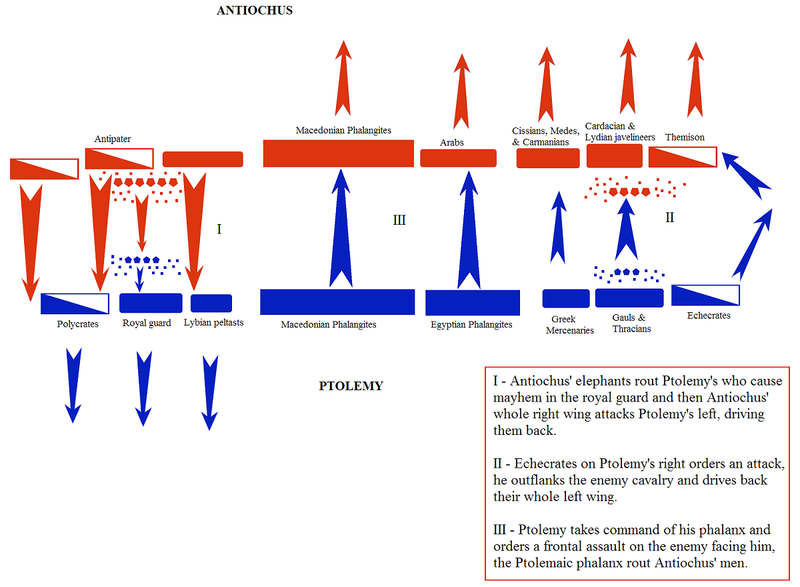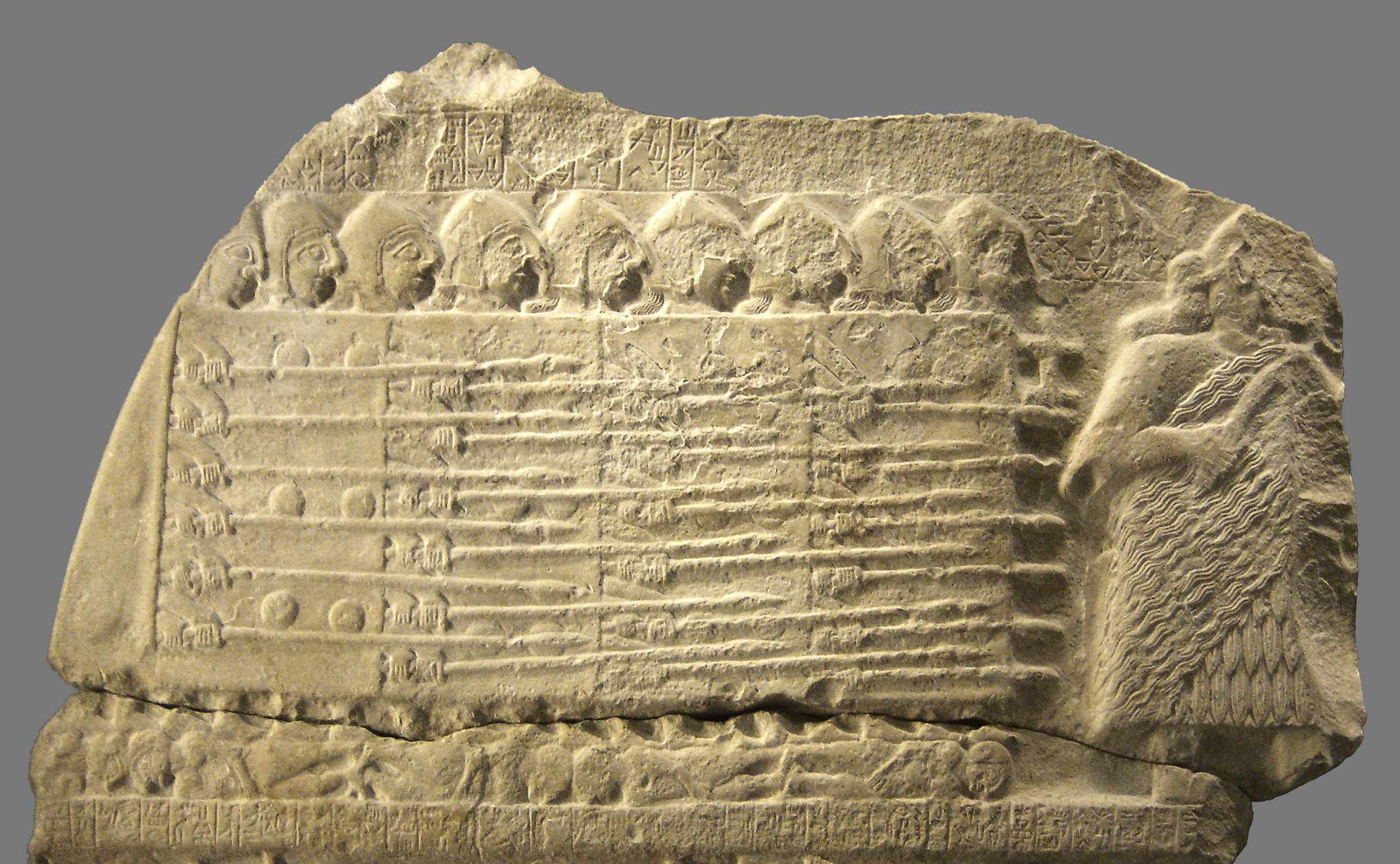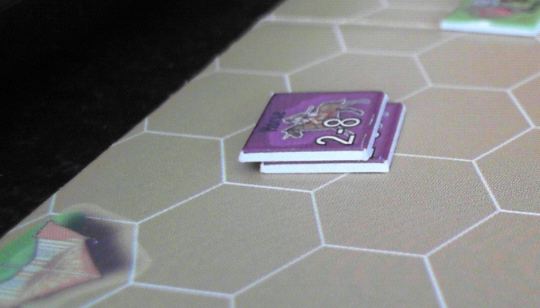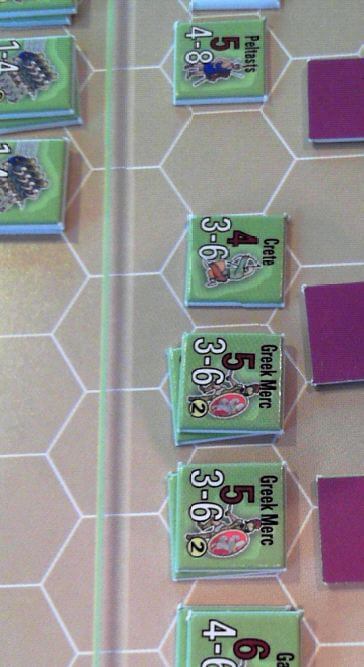I played Raphia on the 2oth of August this year. A snap purchase made after vacillating about the likely merits of Raphia under the auspices of the SCS system. Coming from the perspective of a Great/Simple Great Battles of History player Raphia was an intriguing and different experience than I was expecting.
The cinematic, grand sweep of Ancient combat that we see in movies, dvds and youtube clips is something that I have always thought would be fabulous to encounter in a game. Would Raphia deliver what GBoH attempted to?
For me the things that can be seen in the minds eye when a battle rages from this period are the masses of troops in formation marching in tight order. Leaders astride horses exhorting their men to conquer their fears. The hacking, slashing, pushing and shoving at each other. We can see the movement of skirmishers, and chariots, the charge and counter charge of cavalry. Elephants going into some sort of crazy rampage at just the wrong time, the horses rearing, sarissa being lowered, men bracing for the onslaught of a shield wall charge and arrows, javelins and stones flying. Chaos usually ensues and the battle flows forward and back in massive waves. I use the word waves. As often thats what appears to have happened based upon the reading of Herodotus, Livy, Polybius and Arrian. Waves of action. One wing suffers, the other succeeds, the center attacks, the flanks feint. So it goes on and on.
Yet how would a mostly WWII set of rules apply to the massively different technology, formation, command situation and settings of the ancient era?
I was prepared to explore this and share the experience with you.
The Battle of Raphia (ref Wiki).
Antiochus’ army was composed of 5,000 light armed Daae, Carmanians and Cilicians under Byttacus the Macedonian, 10,000 Phalangites (the Argyraspides or Silver Shields) under Theodotus the Aetolian, the man who had betrayed Ptolemy and handed much of Coele Syria and Phoenicia over to Antiochus, 20,000 Phalangites under Nicarchus and Theodotus Hemiolius, 2,000 Persian and Agrianian archers and slingers, 1,000 Thracians under Menedemus of Alabanda, 5,000Medes, Cissians, Cadusii and Carmanians under the Aspasianus the Mede, 10,000 Arabians under Zabdibelus, 5,000 Greekmercenaries under Hippolochus the Thessalian and 1,000 Neocretans under Zelys the Gortynian, 500 Lydian javelineers and 1,000 Cardakes under Lysimachus the Gaul.
4,000 horse under Antipater, the nephew of the King and 2,000 under Themison formed the cavalry and 102 war elephantsof Indian stock marched under Philip and Myischos.
Ptolemy had just ended a major recruitment and retraining plan with the help of many mercenary generals. His forces consisted of 3,000 Hypaspists under Eurylochus the Magnesian (the Agema), 2,000 peltasts under Socrates the Boeotian, 25,000 Phalangites under Andromachus the Aspendian and Ptolemy, the son of Thraseas, and 8,000 Greek mercenaries under Phoxidas the Achaean and 2,000 Cretan and 1,000 Neocretan archers under Philon the Cnossian. He had another 3,000 Libyans under Ammonius the Barcian and 20,000 Egyptians under his chief minister Sosibius trained in the Macedonian way. Apart from these he also employed 4,000 Thracians and Gauls from Egypt and another 2,000 from Europe under Dionysius the Thracian.
His Household Cavalry (tis aulis) numbered 700 men and the local (egchorioi) and Libyan horse, another 2,300 men, had as appointed general Polycrates of Argos. Those from Greece and the mercenaries were led by Echecrates the Thessalian. Ptolemy’s force was accompanied by 73 elephants of the African stock.
Polybius writes in some detail in Book 5 of The Histories about the battle:
“3 Reaching the spot he was bound for on the fifth day he encamped at a distance of fifty stades from Raphia, which is the first city of Coele-Syria on the Egyptian side after Rhinocolura. 4 Antiochus was approaching at the same time with his army, and after reaching Gaza and resting his forces there, continued to advance slowly. Passing Raphia he encamped by night at a distance of •ten stades from the enemy. 5 At first the two armies continued to remain at this distance from each other, 6 but after a few days Antiochus, with the object of finding a more suitable position for his camp and at the same time wishing of encourage p199his troops, encamped so near Ptolemy that the distance between the two camps was •not more than five stades. “
Thus than 1000m apart the two armies sat for some time. The battle description goes on to explain how according to Polybius the difference in Elephant breeds cause Ptolmey some issues.
“Ptolemy’s elephants were thus thrown into confusion and driven back on their own lines, Ptolemy’s guard gave way under the pressure of the animals”
Then Ptolmey’s officers seeing the cloud of dust, set to rectifying the situation as the entire Left wing was collapsing:
“Echecrates who commanded the right wing at first waited for the result of the engagement between the other wings, but when he saw the cloud of dust being carried in his direction, and their own elephants not even daring to approach those of the enemy, 2 he ordered Phoxidas with the mercenaries from Greece to attack the hostile force in his front, 3 while he himself with his cavalry and the division immediately behind the elephants moving off the field and round the enemy’s flank, avoided the onset of the animals and speedily put to flight the cavalry of the enemy, charging them both in flank and rear. “
“Antiochus’ right wing then was victorious,” When out of the center Ptolmey appears and urges his men on “but Ptolemy having retired under shelter of the phalanx suddenly came forward and showing himself to his troops caused consternation among the enemy and inspired his own men with increased alacrity and spirit. 9 Lowering their pikes (the translation I used online uses the word spearman or αἰχμοφόρος rather than σαρισοφόρος for Sarissa) , therefore, the phalanx under Andromachus and Sosibius advanced to the charge. 10 For a short time the picked Syrian troops resisted, but those under Nicarchus quickly turned and fled. “
Classic Ancient theater right before our very eyes.
The battle played out as in this diagram here:

The Game
First off, the SCS rules that apply are rudimentary. Sections 3, 4, 8 and 9 and in fact only parts of them. So in essence movement, stacking, step losses and retreat, are applied. Most of which are modified within the Raphia specific rules.

In the picture above note on the left the turn sequence, very straight forward. The map contains reminders on ratings for units and other relevant detail. There are a few details that should be borne in mind, as they impact the flavor the game greatly. Zones of Control are either Sticky or Locking. Your movement stops when you move adjacent to an enemy unit! Shocking? No. There is more to it. ZOCs exert control unless you are going to Melee. In which case you move your unit into the enemies hex. This applies for all the eligible units that are conducting melee.
Now if you are not going to Melee, you may move into another hex as long as it is not a sticky ZOC as well. Some words in parentheses confuse this however in 2.0b, and for me left some doubt as to when and how I may leave a sticky hex.
The deeper heavier formations such as Phalanxes have a different impact when moved adjacent to another Phalanx. They Lock.
The Phalanx style units at the battle of Raphia were different from the typical Greek Hoplites of the era. Being Post Alexandrian, these infantryman deployed in a phalanx, but the infantryman was the Macedonian “sarissa-bearer” who had a tactical advantage over other phalangites because of their extremely long pikes known as a sarissa 6m in length versus 2-3m in length for the typical Hoplite. Both armies had at least 20,000 men armed in this manner. This fact is explicitly stated in Book V of the Histories: “Both of them placed the phalanxes of the picked troops armed in the Macedonian fashion confronting each other in the centre.”
These soldiers and their sarissas were mainly developed by Philip II of Macedon and his son Alexander the Great as an expansion on and counter to the hoplites of Ancient Greece. It is safe to assume that during the Successor period that the formations we are using here were of this nature, rather than the shorter dory or spear armed Hoplite.
So when two Phalanx meet they lock and enter into a “Pushing “ contest, a difference to Melee combat. By pushing each other in rounds in order to apply Pressure, a result is eventually incurred in the form of lost steps.
Pressure is released and resolved via a die roll against Morale + Pressure value (#of steps + 1d6). At turn end the pressure marker comes off.

Since the pressure number has no meaning above 4, there is no need to leave it on. Units are locked in place in essence until one side gives. This builds tension for both players. The rounds ‘reset’ the pressure, thereby showing the ebb and flow of the shoving. The locking provides us with the inherent ongoing pressure, the reset of Pressure markers allows for the dice and additional steps brought to bear to bring the conflict to its inevitable conclusion.
One side will either be forced to retreat or die. This has the effect of drawing units to the fray, as the conflict rolls across the line. There is no movement for the Locked Phalanx units!
The Move/Melee function has the step wise impact of one unit creating havoc, then the next then the next. Depending on where you start, what the predetermined result is, and your strategy, waves of movement can occur across the map. An impressive sight.
Cavalry will always retreat from a Phalanx, as will Skirmisher/Peltasts and Mercs.

Note: That some less informed people might assume that the Phalangite was the same as a simple Medieval Pikeman. This is not the case. Excluding metallurgy and armor lets look at use of the Phalanx in combat in the two periods Classical Ancients and Medieval .
If we look at the the Swiss Mediveal Pikemen who fort in blocks as an example, we can see the differences. They had a simple method of controlling their blocks of men. They moved themselves in march columns and extended to line in echelon. The Swiss had a apparently limited understanding of what the phalanx was… a solid mass of weapons broken up into blocks to march.
Speira (later referred to as syntagma in Hellenistic theoretical treatises) were articulated as smaller columns with more attention to parade of units in grand-tactical formations. It seems there isn’t much artistry going on when a layman looks at “they formed a double phalanx in echelon with left wing refused, and organized reserves to cover the flanks”, but Hellenstic grand-tactics demanded tight coordination of speira and of other arms to generate a combined-arms synthesis so as to orchestrate some rather telling movements of the phalangites themselves, witness the Alexandrian combats in the Balkans and Central Asia.

Under most set-piece fights the Greeks kept the “pike style”-armed men in two wings (often one refused) and relied on it to fix the enemy frontally by the demonstration of march while hoplites, peltasts, and cavalry sought to clear a path for flank maneuver against enemy flankers and reserves.
Whereas Swiss armies were very careful in posting themselves where the vulnerable flanks and rear were covered. Swiss pikeman were in some cases able to bring variations on formation to bear successfully, and used a variety of pike styles (halberd etc) and even included crossbowmen in a combined arms style formation. The reputation of the Swiss manifest itself thru the victories earned until the advent of the musket. There is little record of them employing articulate units to adjust flank coverage or react as reserves to contingencies; they planned pressure en echelon and committed to it. This is an important point when distinguishing the Swiss practice of marching and fighting by columns, and the ancient-world practice of parading an array of units whose troop numbers were calculated according to estimates of a leader’s span-of-control, in ways that brought arms into superior positions overlapping the enemy, with reserves and idle sub units marshaled to react to contingencies.
Swiss halberdiers are obviously in a better position with their ability to lift and hack down, but the characteristic forest of pikes in the Hellenistic style would work to entangle halberd shafts seeking to shift in either the vertical or horizontal plane. It was enough to afford shelter against arrows, historically. The differences are stark enough to warrant the usage of the correct term – Sarissa armed men versus Pike or Halberd armed men in a Phalanx vs Block formations.
The CRT therefore rewards the thoughtful timely use of your resources. One unclear aspect, Cavalry have no effect upon the Phalanx if it enters its hex, yet their action will result in them being in the hex. Does the attacking unit then move out? If so where? Or since there is no effect, does the Cav unit now exert its sticky ZOC, does it do that in the hex or out of the hex from whence it came? What happens on the next turn when it is time for the Phalanx to move? Does that simply count as a full MA retreat? I assumed so.
Therefore cavalry unit perhaps serves the purpose of extending its sticky ZOC for a period of time? The Phalanx will have to either attack the Cavalry or move to force it out of the hex, thus the Cavalry unit would then retreat its full MA. Seems pointless to have your cavalry thrust back across the field just so the horse can leave droppings near the Phalanx!
Other effects for Cavalry are simple Melee and the more devastating Trample where the trampled unit must pass a morale check or lose a step AND retreat its full MA.

It is actions of units, their consequences and subsequent ripple effect that captures the mood of the era. Once your units have all moved, retreated, caused retreats, fired at each other, and trampled the line will look markedly different than at the beginning of the turn!
That is when the Cavalry have thier exploitation phase. With a full turn of movement they can drive thru the lines, block retreats or head for the Victory condition hex ( Camp of the enemy).

Elephants may play a significant role in the outcome of any battle. Their status is resolved for both sides in the Elephant recovery phase. Dice are rolled for direction of panic, who they influence (Trampling their merry way across both sides.) often in a daisy chain effect.

A unit type that is often ignored and apparently made light of in the rules here is the missile bearing unit. Javelins, Peltatists and Archers can deliver pain at range in this game. In my first play thru the Selecuids were devastated by the Egyptians with superior Archery.

The first play thru which is posted in the Facebook page of the Big Board shows a pictorial run representation. Due to some errors in play and tentativeness in movement the feeling of riveting narrative, rolling waves of combat and the ebb and flow of the tides of war were absent.
The 2nd play thru more accurately captured those impressions however. The battle field chaos, rally comes to the fore. The to and fro of retreating units, the clash of arms, the cavalry break through attempts, all nicely characterize the image of waves of action. Its a tad crowded even for a magazine game however.
The 2nd play thru will be available on:
http://www.youtube.com/user/hipshot0710?feature=mhee
There are 2 games in this magazine Special Operations. Plus several articles. Lots of ASL stuff. So little of interest for me except this game.
Is Raphia worth the admission price alone? Likely not. Whilst it captures much of the feel of battle in this era, there are elements missing that I would enjoy seeing in further editions of this “SCS Ancients” system.
Firstly a larger less cramped map (lets start with larger hexes), some thought about terrain and its impact given that over 50% of all battles in this period used a river, stream or a hill to improve their chances of success (see www.meshtime.com/tags/GBoH). More granular CRT. Further thought about retreat and Elephants. Tweaking of the Cavalry secondary movement. Considerations of Rear Flank attacks. Finally the impact of Leadership. Now I am not asking for GBoH. No! I think the fluidity that comes from this systems approach can be further enhanced. I would say then that the company has a ‘new’ system in its hands that could be applied nicely to board gaming OR other mediums. The game has some replay value, appears to work well for classical ancients, I think that more effort would be required to cater for the Roman Period, the Ostragoths and their ilk, and late Ancients would need careful work to avoid a generic outcome of every battle and to cater for the different weapons systems.
This game could serve as a nice introduction to the Ancients era if you wanted to get someone interested in what the period was all about. That feel certainly comes out. I was however hoping for a more impacting experience. I almost go it. But not quite.
Great review, Hipshot. Definitely captures the essence of the game!
Thanks Eric, glad you dropped by to see the site.